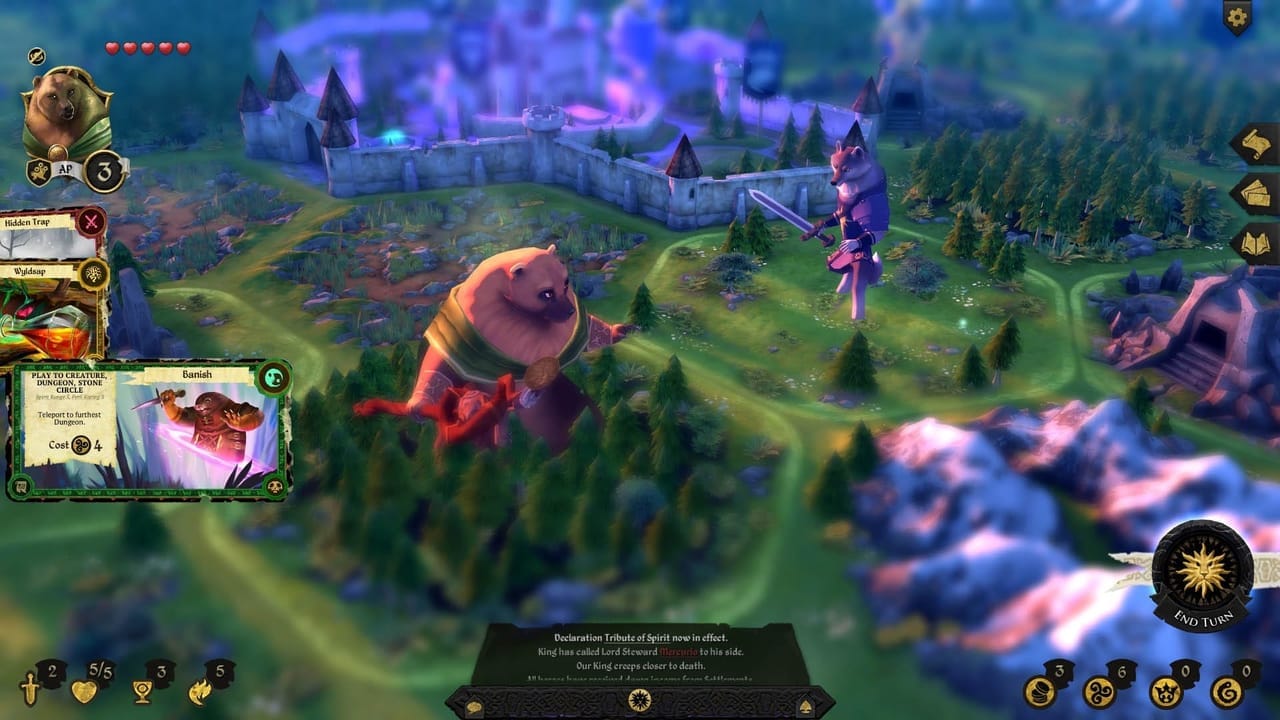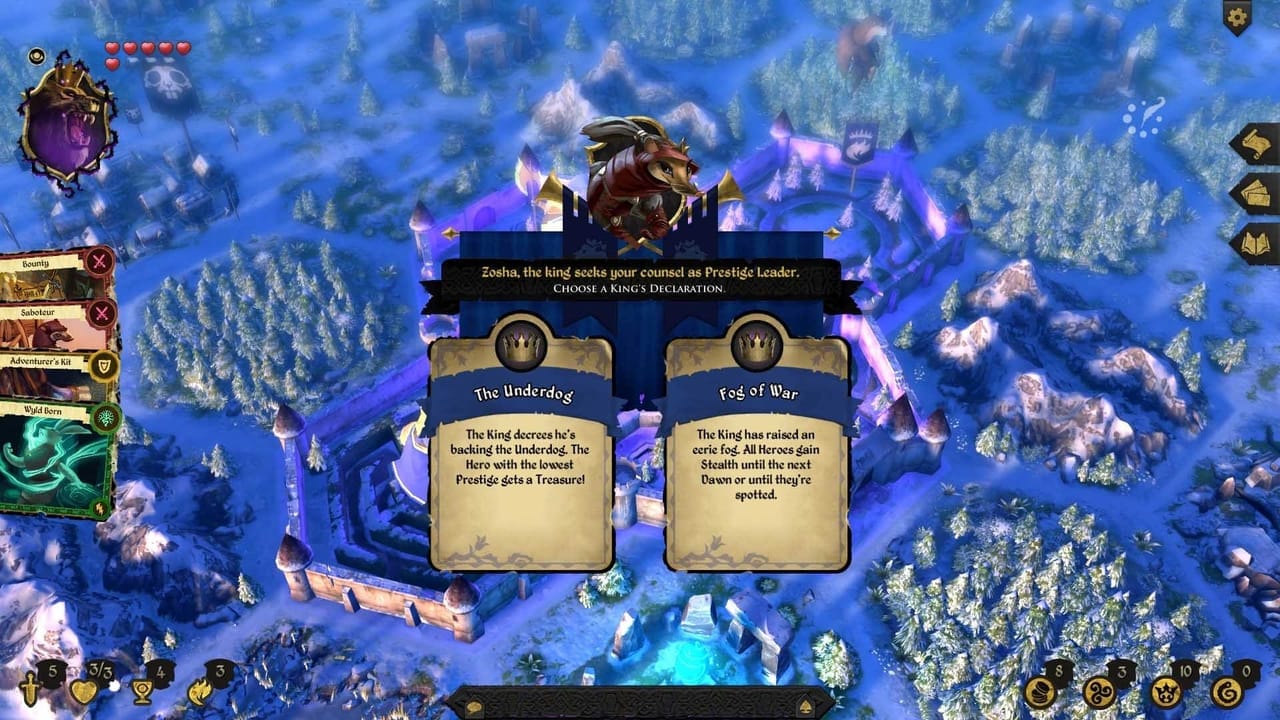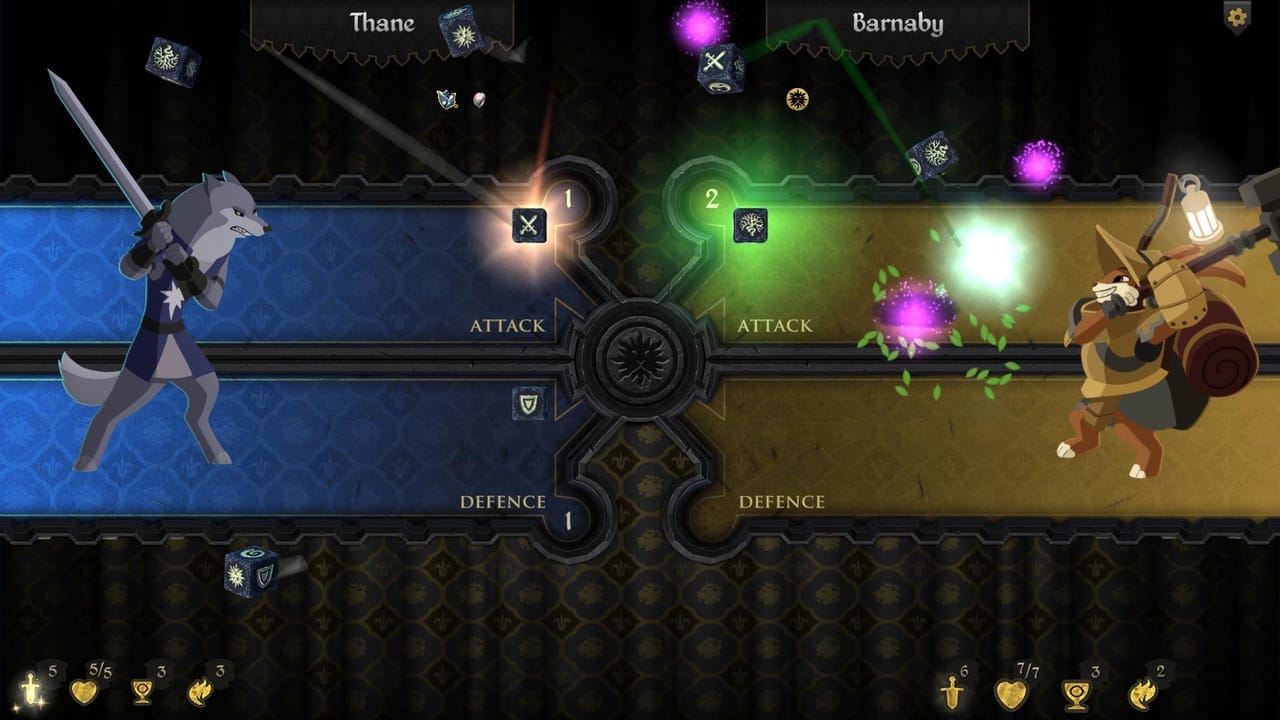Armello is strange; it is a Kickstarted digital board game with a distinctive Redwall fairy ahem tail aesthetic—an intriguing combination that could have easily gone awry.
The first thing that is obvious is that Armello looks great, as the characters, locations, and tiles themselves nail the fantasy look League of Geeks were no doubt aiming for. Soundwise, the game is vibrant; everything sounds as it should, from the hustle and bustle of villages to the vigorous roar of the King that determines the start of each turn. The soundtrack itself is subtle but engrossing, lending the game an ethereal feeling that does credit to its world-building and setting. If one were to nitpick, the volume of the King’s roar is perhaps a little too loud and the sound of swordplay is a tad overblown, but otherwise there really are no complaints to be had with both the sound and visuals of Armello.
There is always something occurring on the board, even when it is not your turn—always something to look at and admire. Every in-game character is unique, both in playstyle and in looks, which is excellent for both replayability and to keep the game interesting. It is a board game after all, and while there are in-game quests to spice the game up, it really is the players or their avatars themselves that make Armello a relatively dynamic experience.

For the game itself, the way one can win is very simple: either you kill the King and claim his crown, or you heal him of the disease called the Rot.
Achieving victory is attainable through four different ways – via gathering a sufficient amount of Rot (at least five) and killing the king in combat, simply killing him in combat, and by healing him by collecting four Spirit Stones, the antithesis or the "pure" method in comparison to a Rot victory. The last way of achieving victory is through gathering prestige, which players acquire by myriad of means, such as completing quests and defeating other players.
As a result of this, usually a regular game of Armello ends in a Prestige victory (as the King eventually dies if no one kills him) although it is possible to win through the other ways mentioned. This isn't a complaint, but it isn't a compliment either, and perhaps League of Geeks should look into making all avenues of victory equally viable in the future.
Storywise, in the land of Armello the wildcat King is dying from a plague-like disease called the Rot. To elaborate, the Rot slowly drives its bearer insane, killing its host eventually in a long excruciatingly painful fashion. Rot itself is gathered via a myriad of different ways, such as by playing cards or by being killed by wandering NPC’s called Banes—which themselves stem from the King’s Rot every turn.
With the King’s decline, the other animal "clans" such as the Wolves, Rabbits, Rats, and Bears collectively realize that with the King’s insanity the throne is now up for grabs, as evidenced by the increasingly ridiculous proclamations that he issues at the beginning of each turn.

As a result of this civil strife, the game formally begins, with the aforementioned ways of victory encouraging players to help shape each round of Armello into something different through regular play. However, these avenues of victory are singular, so the average game features rampant backstabbing, plotting, and death—the regular board game experience.
The game begins with each player being presented three quests—which are differentiated by whether you prefer loot, spirit stones, or an increase in reputation—and by drawing a minimum of four cards, which are in turn differentiated in cost by item, spell, and trickery.
To explain quickly, Item Cards are things that one can equip, such as weapons or followers that gives one special abilities, such as being able to re-roll in specific circumstances. Spells are as what one would expect, spell cards that can either be used to harm others or enrich yourself. Finally, Trickery cards are cards that are used to further your goals by causing deliberate misfortune upon others, such as causing ranged damage or by performing laying perils, a sort of trap that if not mitigated does damage to player, physically and sometimes monetarily.
For a board game, there is a relatively impressive amount of things to do, and as such, one is never bored during their turn. During one’s turn, one could try and complete a quest, attack another player, go tomb raiding (almost quite literally), try to complete a peril (a sort of trap), or move towards completing some other objective that one can complete. Overall, when you are playing your turn, the game is an engrossing experience.
However, that cannot be said for when the other players are playing. This can be cut down to two different reasons: a lack of interactivity and a lack of communication. There are ways around this, but they are unsatisfactory to differing degrees.
For the lack of interactivity, there really is not much to do during another opponents turn other than try to play a trickery card at some point. Seemingly, Armello is one of those games where it is indeed fun to play during your turn but boring to watch an opponent go through their turn.

One of the main points of appeal for a board game is not just the fact that you are looking for a good game, but also that you have good co-players that help make the experience memorable. Armello doesn’t really offer a dedicated chat system, as instead it uses a selection of words and phrases that in the end gets the job done, but it also misses the point. For a game like Armello, the value of real in-game communication cannot be underestimated, and its absence is a real headscratcher.
Overall, Armello is a good game and it competently achieves what it sets out to do. For those interested in the setting and like board games, it is a worthwhile purchase, although perhaps for a truly rewarding experience you should bring some friends.
Armello was obtained from the developer and reviewed on Steam.
Review Summary
In the end, Armello does not strive for anything more than being a polished and well-rounded experience, and despite some lingering complaints on its lack of communication and interactivity, it is a worthwhile purchase for any board game fan.
(Review Policy)Have a tip, or want to point out something we missed? Leave a Comment or e-mail us at tips@techraptor.net













